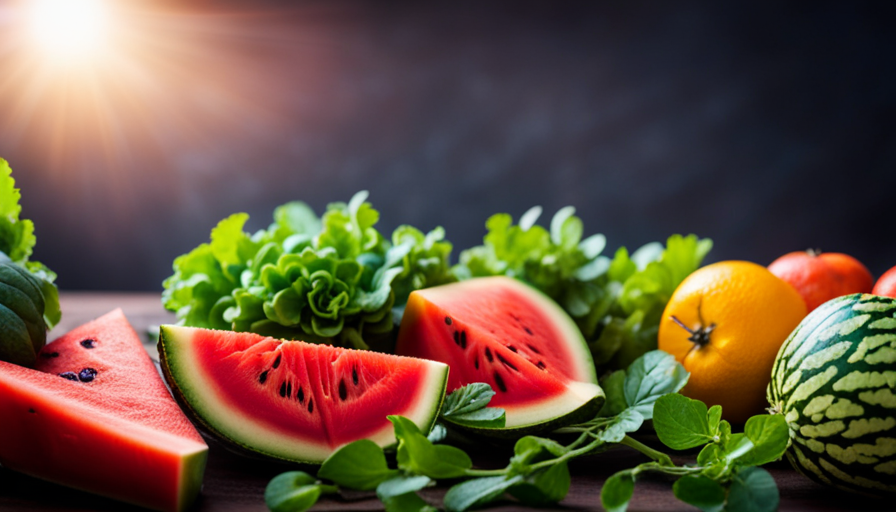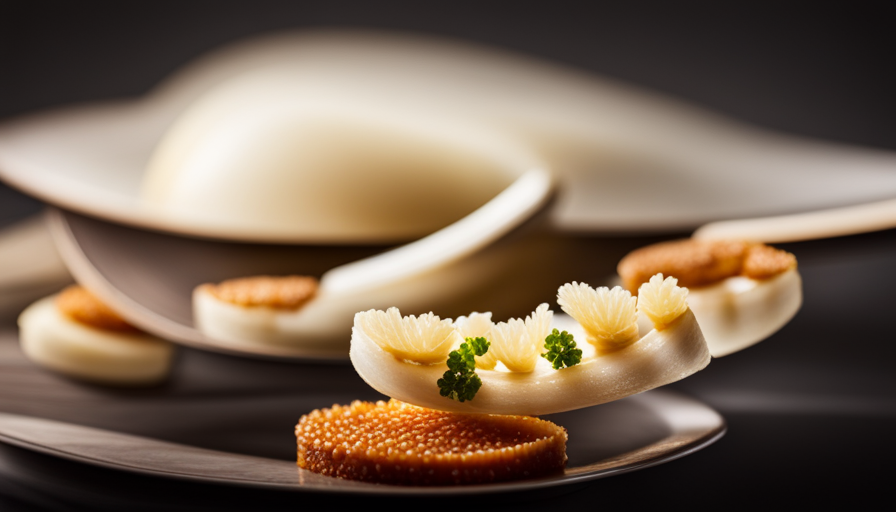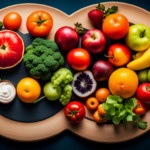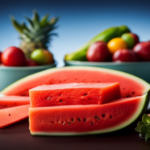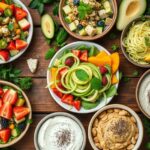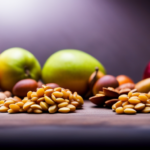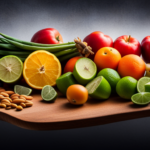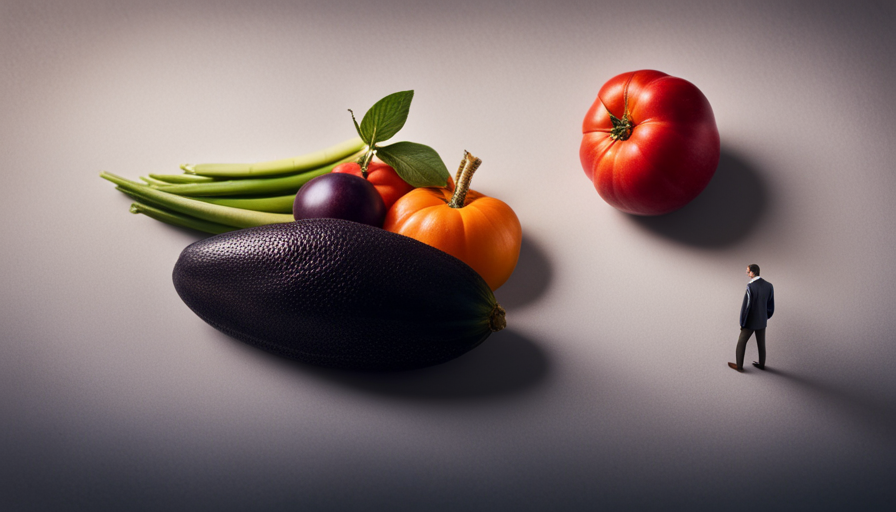Ever curious about the diet of raw food vegans?
I mean, how can they possibly get all the nutrients they need without cooking their food?
Well, let me tell you, it’s not as difficult as you might think.
Raw food vegans focus on consuming unprocessed, plant-based foods that are packed with vitamins, minerals, and enzymes.
They believe that cooking destroys these essential nutrients, so they opt for a diet that consists mainly of fruits, vegetables, nuts, seeds, sprouts, raw grains and legumes, fermented foods, and raw dairy alternatives.
And yes, even desserts can be enjoyed in their raw form!
But don’t worry, meal planning as a raw food vegan doesn’t have to be complicated.
With a little creativity and some helpful tips, you can easily incorporate these nutritious foods into your daily routine.
So, if you’re curious about what raw food vegans eat and how you can incorporate these foods into your own diet, keep reading!
Key Takeaways
- Raw food vegans focus on consuming unprocessed, plant-based foods packed with vitamins, minerals, and enzymes.
- Raw fruits, vegetables, nuts, seeds, sprouts, raw grains and legumes, fermented foods, and raw dairy alternatives are staples in a raw food vegan diet.
- Soaking and sprouting nuts, seeds, grains, and legumes enhances their digestibility and increases their nutrient availability.
- Superfoods like berries, leafy greens, nuts, and seeds should be incorporated into the diet for essential nutrients and optimal health.
Fruits
You’ll be amazed at the vibrant array of juicy, succulent fruits that raw food vegans indulge in! Raw food vegans rely heavily on fruits as a staple in their diet. Not only are fruits delicious, but they’re also packed with essential vitamins, minerals, and antioxidants.
One popular technique that raw food vegans use is soaking fruits to enhance their flavor and texture. Soaking fruits like berries and grapes in water for a few hours can make them plumper and juicier, making them even more enjoyable to eat.
Another favorite among raw food vegans is making raw fruit smoothies. These smoothies are made by blending a variety of fruits together, creating a refreshing and nutritious drink. Raw fruit smoothies aren’t only a great way to consume a large quantity of fruits at once, but they also provide a quick and convenient source of energy.
Now, let’s move on to the next section and explore the world of delicious raw vegetables!
Vegetables
For a satisfying meal, try roasting a medley of colorful vegetables like peppers, zucchini, and eggplant until they’re tender and caramelized.
Raw food vegans have a plethora of vegetable options to choose from in their meal prep. Vegetables aren’t just nutritious but also versatile in recipes. They can be enjoyed raw in salads, blended into smoothies, or even dehydrated to create crispy snacks.
One popular vegetable recipe among raw food vegans is zucchini noodles, also known as ‘zoodles.’ These noodles can be made by using a spiralizer to turn zucchini into long, thin strands resembling pasta. They can be paired with a variety of raw sauces like pesto or marinara for a delicious and healthy meal.
Another vegetable that’s commonly used in raw food vegan recipes is kale. This leafy green is packed with nutrients and can be used as a base for salads or blended into smoothies. It can also be massaged with a dressing to soften its texture and enhance its flavor.
Transitioning to the next section about nuts and seeds, they’re often incorporated into raw food vegan recipes to add texture and flavor.
Nuts and Seeds
Nuts and seeds are a treasure trove of crunchy goodness and are often sprinkled over salads or blended into creamy dressings for an added burst of flavor. These nutrient-rich powerhouses not only provide a satisfying crunch but also offer numerous health benefits.
One popular technique used by raw food vegans is soaking, which involves soaking nuts and seeds in water to enhance their digestibility. Soaking also helps to remove enzyme inhibitors and phytic acid, making these foods easier to absorb and reducing the likelihood of digestive discomfort.
In addition to being a delicious and convenient snack, nuts and seeds are packed with essential nutrients. They are excellent sources of plant-based protein, healthy fats, fiber, vitamins, and minerals. Almonds, for example, are rich in vitamin E, magnesium, and calcium, while chia seeds are loaded with omega-3 fatty acids and antioxidants. Incorporating a variety of nuts and seeds into a raw food vegan diet can contribute to overall health and well-being.
As we transition into the next section about sprouts, it’s important to note that sprouting nuts and seeds is another technique embraced by raw food vegans. Sprouting enhances their nutritional value by increasing the bioavailability of nutrients and reducing anti-nutrients.
So, let’s explore the fascinating world of sprouts and their role in a raw food vegan diet.
Sprouts
Sprouts are a living food that bursts with vitality, providing a vibrant and fresh addition to any meal. Imagine biting into a crisp and juicy sprout-packed salad that invigorates your taste buds and leaves you feeling energized.
Sprouts are the young shoots of seeds, such as alfalfa, broccoli, or mung beans, that have just begun to grow. They’re packed with nutrients, including vitamins A, C, and K, as well as minerals like potassium and iron.
Raw food vegans often incorporate sprouts into their diets due to their numerous health benefits. Sprouts are known to support digestion, boost the immune system, and improve overall health. They’re also a great source of enzymes, which aid in the digestion and absorption of nutrients.
There are many delicious sprout recipes that raw food vegans can enjoy. Sprouts can be added to salads, wraps, stir-fries, and smoothies. They can also be used as a topping for sandwiches or blended into dips and spreads.
Moving on to the next section about raw grains and legumes, these food groups are staples in a raw food vegan diet and provide essential nutrients and energy.
Raw Grains and Legumes
When it comes to raw grains and legumes, there are plenty of options for raw food vegans like myself. Some examples of raw grains include quinoa, buckwheat, and wild rice. Raw legumes can include chickpeas, lentils, and mung beans. Soaking and sprouting these grains and legumes is a common practice in the raw food community, as it helps to remove enzyme inhibitors and increase nutrient availability.
There are also a variety of recipes that incorporate raw grains and legumes, such as raw vegan sushi rolls with sprouted quinoa or raw lentil hummus.
Examples of raw grains and legumes
If you’re looking to diversify your raw food vegan diet, you’ll be pleasantly surprised by the variety of raw grains and legumes available to you. Incorporating soaked grains and raw lentils into your meals can provide you with a great source of nutrients and add texture to your dishes.
Here are three examples of raw grains and legumes that you can include in your diet:
-
Raw Buckwheat: This gluten-free grain is rich in fiber, protein, and essential minerals like magnesium and manganese.
-
Raw Quinoa: Known for its complete protein profile, raw quinoa is also packed with fiber, iron, and antioxidants.
-
Raw Chickpeas: These legumes are high in protein, fiber, and several vitamins and minerals, making them a nutritious addition to your meals.
By soaking and sprouting grains and legumes, you can enhance their nutritional value and make them easier to digest. Transitioning into the subsequent section, let’s explore the benefits of soaking and sprouting grains and legumes.
Soaking and sprouting grains and legumes
To enhance the nutritional value and improve digestion, you can easily incorporate soaked and sprouted grains and legumes into your diet. Soaking is a simple technique that involves soaking the grains or legumes in water for a certain period of time, usually overnight. This process helps to break down phytic acid, a compound that can hinder the absorption of nutrients in the body. It also helps to soften the grains and legumes, making them easier to digest.
Sprouting, on the other hand, involves allowing the grains or legumes to germinate by rinsing and draining them regularly. This process increases the nutrient content and makes them more bioavailable. Soaking and sprouting grains and legumes have been associated with various health benefits, including increased nutrient absorption, improved digestion, and reduced anti-nutrient content.
Incorporating soaked and sprouted grains and legumes into your diet can be a great way to boost your overall health and well-being.
In the subsequent section, we will explore some delicious recipes using raw grains and legumes.
Recipes using raw grains and legumes
Let’s delve into some mouthwatering recipes that incorporate the goodness of soaked and sprouted grains and legumes! Raw grain recipes and legume recipes can be incredibly versatile and delicious. Here are a few ideas to get you started:
-
Raw Quinoa Salad: Mix sprouted quinoa with fresh vegetables like cucumber, cherry tomatoes, and bell peppers. Drizzle with a tangy dressing made from lemon juice, olive oil, and herbs.
-
Sprouted Lentil Soup: Combine sprouted lentils with diced carrots, celery, and onions in a flavorful vegetable broth. Add spices like cumin and turmeric for an extra kick.
-
Raw Buckwheat Wraps: Blend soaked buckwheat groats with water to create a batter. Spread the batter thinly on a dehydrator tray and let it dry until pliable. Fill with your favorite veggies and spreads for a healthy wrap.
-
Sprouted Chickpea Hummus: Blend sprouted chickpeas with garlic, tahini, lemon juice, and olive oil for a creamy and nutritious dip.
Table of Some Mouthwatering Raw Grain and Legume Recipes:
| Recipe Name | Ingredients |
|---|---|
| Raw Quinoa Salad | Sprouted quinoa, cucumber, cherry tomatoes, bell peppers, lemon juice, olive oil, herbs |
| Sprouted Lentil Soup | Sprouted lentils, carrots, celery, onions, vegetable broth, cumin, turmeric |
| Raw Buckwheat Wraps | Soaked buckwheat groats, water, assorted veggies, spreads |
| Sprouted Chickpea Hummus | Sprouted chickpeas, garlic, tahini, lemon juice, olive oil |
These recipes provide a great way to incorporate raw grains and legumes into your diet, providing essential nutrients and a burst of flavor. Now, let’s explore the world of superfoods and their health benefits.
Superfoods
Superfoods are nutrient-rich foods that are believed to provide exceptional health benefits. Some popular examples of superfoods include berries, leafy greens, nuts, and seeds. As a raw food vegan, incorporating superfoods into my diet is essential for getting a wide range of nutrients and maintaining optimal health.
Introduction to superfoods
When you’re a raw food vegan, you’ll discover a whole world of nutritious and delicious ingredients that can take your meals to the next level. Superfoods are a key component of the raw food diet, offering a wide range of health benefits.
Here are four reasons why superfoods should be a part of your diet:
-
Superfood smoothies: Blend together a variety of superfoods like kale, spinach, berries, and chia seeds for a nutrient-packed and refreshing drink that’ll leave you feeling energized.
-
Raw food diet benefits: Incorporating superfoods into your raw food diet can provide essential vitamins, minerals, antioxidants, and phytochemicals. These nutrients support overall health, boost the immune system, and reduce the risk of chronic diseases.
-
Increased energy levels: Superfoods are rich in nutrients that provide sustained energy throughout the day, helping you stay active and focused.
-
Improved digestion: Many superfoods are high in fiber, which aids in digestion and promotes a healthy gut.
Transitioning to the next section about examples of popular superfoods, you’ll find a wide variety of options to choose from.
Examples of popular superfoods
Explore the world of popular superfoods and discover a plethora of nutrient-rich options that’ll leave you feeling vibrant and healthy.
Superfood smoothie recipes offer a convenient and delicious way to incorporate these powerhouse ingredients into your diet. Blend together a mix of kale, spinach, berries, and chia seeds for a refreshing and nutrient-packed start to your day.
Nutrient-dense salads are another fantastic way to enjoy superfoods. Combine leafy greens, such as kale or spinach, with avocado, quinoa, and a variety of colorful vegetables for a satisfying and nourishing meal. These salads provide a wide range of vitamins, minerals, and antioxidants that support overall health.
By incorporating superfoods into a raw food vegan diet, you can maximize your nutrient intake and experience the benefits of these incredible ingredients.
Transitioning into the next section, let’s explore the various ways to incorporate superfoods into your daily meals.
Incorporating superfoods into raw food vegan diet
Indulge in the wonders of a raw food vegan diet and discover the ingenious ways to include these extraordinary ingredients in your daily meals.
When it comes to incorporating superfoods into a raw food vegan diet, one effective method is soaking and sprouting grains. This process helps to increase the nutrient content and digestibility of grains, making them a valuable addition to your meals.
Soaking grains overnight breaks down the enzyme inhibitors and phytic acid, which can interfere with nutrient absorption. Sprouting grains takes it a step further by activating enzymes that increase the nutrient content and make the grains easier to digest.
Incorporating these soaked and sprouted grains into your meals can provide a nutritious and satisfying base for a variety of dishes.
Now let’s explore the next section about raw dairy alternatives.
Raw Dairy Alternatives
Raw food vegans often enjoy a variety of plant-based options as alternatives to raw dairy products. While traditional dairy products are not consumed in a raw food vegan diet, there are several raw dairy substitutes available that provide similar taste and texture. These alternatives include nut milks, such as almond milk and cashew milk, as well as seed milks like flaxseed milk and hemp milk. These plant-based milks can be made at home using raw nuts or seeds and water, or they can be purchased in stores.
Raw dairy alternatives offer numerous health benefits. They’re typically lower in saturated fat and cholesterol than traditional dairy products, making them a heart-healthy choice. Additionally, they’re rich in essential nutrients like calcium, vitamin D, and omega-3 fatty acids. These nutrients are important for maintaining bone health, supporting immune function, and reducing inflammation in the body.
Transitioning from raw dairy to plant-based alternatives can be a simple and delicious way to incorporate more nutrient-dense foods into a raw food vegan diet. In the next section, we’ll explore another category of foods that raw food vegans often enjoy: fermented foods.
Fermented Foods
Fermented foods offer numerous benefits for our health. They’re rich in probiotics, which help promote a healthy gut and improve digestion. Examples of fermented foods include sauerkraut, kimchi, yogurt, and kefir.
Making fermented foods at home is a great way to ensure they’re fresh and free from additives or preservatives.
Benefits of fermented foods
Including fermented foods in a raw food vegan diet can provide a multitude of health benefits. Fermentation is a natural process that enhances the nutritional value of foods by increasing beneficial bacteria and enzymes.
One of the main benefits of fermented foods is the presence of probiotics, which promote a healthy gut and improve digestion. These probiotics also support the immune system, reduce inflammation, and enhance nutrient absorption.
In addition, fermented foods have been linked to improved mental health and a stronger immune response. There are various types of fermentation methods, including lacto-fermentation, which is used to make sauerkraut and kimchi, and kombucha fermentation, which produces a fizzy and tangy drink.
Incorporating these fermented foods into a raw food vegan diet can provide an array of health benefits. Transitioning to the subsequent section, let’s explore some examples of fermented foods.
Examples of fermented foods
With the tangy flavors and bubbly textures, fermented foods are like a symphony of delight for the taste buds. Not only do they tantalize our senses, but they also offer numerous health benefits. Fermented foods are rich in probiotics, which promote a healthy gut flora and enhance digestion. They also boost our immune system, improve nutrient absorption, and may even help with weight management. The fermentation process involves breaking down sugars and carbohydrates by bacteria or yeast, resulting in the production of beneficial compounds like vitamins, enzymes, and organic acids. Some examples of fermented foods include sauerkraut, kimchi, yogurt, kefir, miso, and tempeh. These foods are not only delicious but also beneficial for our overall well-being. Transitioning into the subsequent section about making fermented foods at home, let’s explore how easy it can be to incorporate these nutritious delights into your daily diet.
Making fermented foods at home
If you’re looking to add a healthy and delicious twist to your meals, why not try your hand at making your own fermented foods at home?
Fermented foods are not only tasty but also offer numerous health benefits. One popular option is fermented beverages, such as kombucha and kefir. These drinks are made through the fermentation process, which involves the conversion of sugars into beneficial bacteria and yeasts. The fermentation process also creates probiotics, which are known for their positive effects on gut health.
Making fermented foods at home is relatively simple and requires just a few ingredients and equipment. By experimenting with different flavors and ingredients, you can create unique and personalized fermented beverages to enjoy.
Now, let’s move on to the next section about raw desserts and explore some mouthwatering treats you can make with raw ingredients.
Raw Desserts
When it comes to raw desserts, there are a variety of options to choose from. Fruit-based desserts are a popular choice among raw food vegans, as they provide a natural sweetness and are packed with vitamins and minerals.
Raw chocolate and cacao treats are another delicious option, offering a rich and indulgent flavor without the guilt.
And if you’re looking for recipes to make your own raw desserts, there are plenty of resources available online that provide step-by-step instructions and ingredient lists to help you create delicious and healthy treats.
Fruit-based desserts
Indulge in a refreshing raw fruit salad as a guilt-free dessert option for raw food vegans. Raw food vegans often enjoy fruit-based desserts because they’re not only delicious but also packed with nutrients.
Fruit-based smoothies are a popular choice, blending together a variety of fresh fruits to create a creamy and satisfying treat. These smoothies can be customized with different combinations of fruits, such as bananas, berries, and tropical fruits, to suit individual preferences.
Another fruit-based dessert option is raw fruit pies, which are made with a crust of nuts and dates and filled with a mixture of fresh fruits. These pies are not only visually appealing but also provide a burst of natural sweetness.
Transitioning to the next section, raw chocolate and cacao treats offer a decadent alternative for those craving a rich and indulgent dessert.
Raw chocolate and cacao treats
Satisfy your sweet tooth with the heavenly richness of raw chocolate and cacao treats, a delectable temptation for any dessert lover. Indulging in these guilt-free delights not only satisfies cravings but also provides numerous health benefits.
Here are three reasons why you should try raw chocolate and cacao treats:
-
Rich in antioxidants: Raw chocolate is packed with powerful antioxidants that help fight inflammation and protect the body against free radicals.
-
Boosts mood and energy: Cacao contains natural compounds like phenylethylamine and anandamide, which can enhance mood and increase energy levels.
-
Supports heart health: Raw chocolate has been found to improve cardiovascular health by reducing blood pressure and improving blood flow.
If you’re interested in incorporating raw chocolate into your desserts, there are plenty of delicious recipes available.
In the next section, we will explore some mouthwatering recipes for raw desserts.
Recipes for raw desserts
If you’re looking to tantalize your taste buds with guilt-free treats, these raw dessert recipes will surely leave you craving for more.
Raw dessert recipes are a great way to satisfy your sweet tooth while still sticking to a healthy raw food vegan diet. These healthy raw desserts are made with wholesome ingredients like nuts, seeds, fruits, and natural sweeteners like dates or maple syrup.
From raw cheesecakes to chocolate avocado mousse, there is a wide variety of delicious options to choose from. Not only are these desserts full of flavor, but they also provide you with essential nutrients and antioxidants.
So go ahead and indulge in these raw dessert recipes, knowing that you’re nourishing your body with every bite.
Now let’s move on to meal planning and tips for a successful raw food vegan lifestyle.
Meal Planning and Tips
When meal planning, I often find it helpful to include a variety of fruits, vegetables, nuts, and seeds in my diet as a raw food vegan. These food groups provide essential nutrients, fiber, and healthy fats that are important for maintaining a balanced and nourishing diet.
One of the meal prep tips that I follow is to make a grocery shopping list before heading to the store. This helps me stay organized and ensures that I have all the ingredients I need for my meals. I also like to plan my meals around seasonal produce, as it’s often fresher and more flavorful.
Additionally, I find it useful to set aside some time each week for meal prep, where I wash, chop, and store my fruits and vegetables in containers or bags for easy access throughout the week.
When grocery shopping, I make sure to choose organic and locally sourced produce whenever possible. This not only supports local farmers but also ensures that I’m consuming the freshest and most nutritious ingredients. I also like to explore different farmers markets and specialty stores to find unique and exotic fruits and vegetables that can add variety to my meals.
Overall, meal planning as a raw food vegan involves incorporating a wide range of fruits, vegetables, nuts, and seeds into my diet while also considering meal prep tips and smart grocery shopping choices.
Frequently Asked Questions
Can raw food vegans consume cooked fruits and vegetables occasionally?
Sometimes, variety is the spice of life, even for raw food vegans like me. While raw food vegans primarily consume uncooked plant-based foods, incorporating cooked fruits and vegetables occasionally can have its benefits.
Cooking can enhance the flavor and texture of certain fruits and vegetables, making them more enjoyable. Additionally, cooking can increase the bioavailability of certain nutrients, such as lycopene in tomatoes.
To maintain a balanced raw food vegan diet, it’s important to prioritize raw foods while occasionally incorporating cooked options for added taste and nutritional benefits.
Are there any specific nuts and seeds that raw food vegans should avoid?
There are some specific nuts and seeds that raw food vegans should avoid in their diet. Some examples include cashews, peanuts, and pistachios, as they’re typically roasted or cooked before consumption.
However, there are plenty of other nuts and seeds that can be enjoyed by raw food vegans, such as almonds, walnuts, chia seeds, and flaxseeds. These nuts and seeds offer various health benefits, including a good source of healthy fats, protein, fiber, vitamins, and minerals.
How can sprouts be safely prepared and stored to prevent foodborne illnesses?
Sprout safety guidelines are crucial to prevent foodborne illnesses. To safely prepare sprouts, start by thoroughly rinsing them with water and soaking them in a solution of water and food-grade hydrogen peroxide to reduce bacteria. It’s essential to store sprouts in a clean, well-ventilated container at a temperature below 41°F (5°C). Regularly inspect them for signs of spoilage and discard if necessary. Following these sprout storage methods can minimize the risk of foodborne illnesses.
Are there any raw grains and legumes that require special soaking or preparation methods?
There are indeed raw grain alternatives that require special soaking or preparation methods. Some examples include quinoa, buckwheat, and amaranth. Soaking these grains before consumption can help improve their digestibility and nutrient absorption.
Additionally, sprouting legumes like lentils, chickpeas, and mung beans can enhance their nutritional value and reduce anti-nutrients. Soaking and sprouting can also increase the availability of enzymes and vitamins in these foods.
Therefore, incorporating these methods can be beneficial for raw food vegans looking to maximize the nutritional benefits of grains and legumes.
Can you provide some examples of commonly used superfoods in raw food vegan diets?
Incorporating superfoods into a raw food vegan diet can provide numerous benefits. These nutrient-dense foods are packed with antioxidants, vitamins, and minerals, which can support overall health and boost the immune system.
Some commonly used superfoods in raw food vegan diets include spirulina, chia seeds, maca powder, goji berries, and cacao nibs. Delicious and simple recipes using these superfoods include chia seed pudding, spirulina smoothies, goji berry trail mix, and raw cacao energy balls.
Is the Raw Food Diet Suitable for Raw Food Vegans?
For raw food vegans, the raw food diet promise of consuming unprocessed, plant-based foods aligns perfectly with their dietary choices. This diet includes fresh fruits, vegetables, nuts, and seeds, offering a wealth of nutrients and health benefits. It’s a suitable and natural fit for raw food vegans seeking a vibrant lifestyle.
Conclusion
In conclusion, raw food vegans have an incredibly diverse and vibrant diet. They enjoy a plethora of fruits, vegetables, nuts, seeds, sprouts, grains, legumes, dairy alternatives, fermented foods, and delicious raw desserts.
Their meal planning and tips ensure they get all the nutrients they need for a healthy lifestyle. It’s truly astounding how they can thrive on such a raw and unprocessed diet.
With so many options, raw food vegans never have a dull moment when it comes to their meals. They truly have mastered the art of living on the wild side of food.

